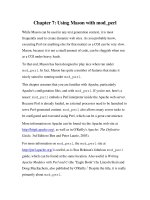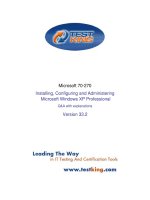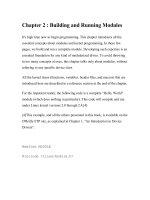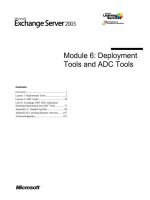Chapter 7 Constructors and Other Tools pptx
Bạn đang xem bản rút gọn của tài liệu. Xem và tải ngay bản đầy đủ của tài liệu tại đây (1.07 MB, 44 trang )
Chapter 7
Constructors and
Other Tools
Copyright © 2006 Pearson Addison-
Wesley. All rights reserved. 7-2
Learning Objectives
♦
Constructors
♦
Definitions
♦
Calling
♦
More Tools
♦
const parameter modifier
♦
Inline functions
♦
Static member data
♦
Vectors
♦
Introduction to vector class
Copyright © 2006 Pearson Addison-
Wesley. All rights reserved. 7-3
Constructors
♦
Initialization of objects
♦
Initialize some or all member variables
♦
Other actions possible as well
♦
A special kind of member function
♦
Automatically called when object declared
♦
Very useful tool
♦
Key principle of OOP
Copyright © 2006 Pearson Addison-
Wesley. All rights reserved. 7-4
Constructor Definitions
♦
Constructors defined like any
member function
♦
Except:
1. Must have same name as class
2. Cannot return a value; not even void!
Copyright © 2006 Pearson Addison-
Wesley. All rights reserved. 7-5
Constructor Definition Example
♦
Class definition with constructor:
♦
class DayOfYear
{
public:
DayOfYear(int monthValue, int dayValue);
//Constructor initializes month & day
void input();
void output();
…
private:
int month;
int day;
}
Copyright © 2006 Pearson Addison-
Wesley. All rights reserved. 7-6
Constructor Notes
♦
Notice name of constructor: DayOfYear
♦
Same name as class itself!
♦
Constructor declaration has no return-type
♦
Not even void!
♦
Constructor in public section
♦
It’s called when objects are declared
♦
If private, could never declare objects!
Copyright © 2006 Pearson Addison-
Wesley. All rights reserved. 7-7
Calling Constructors
♦
Declare objects:
DayOfYear date1(7, 4),
date2(5, 5);
♦
Objects are created here
♦
Constructor is called
♦
Values in parens passed as arguments
to constructor
♦
Member variables month, day initialized:
date1.month 7 date2.month 5
date1.dat 4 date2.day 5
Copyright © 2006 Pearson Addison-
Wesley. All rights reserved. 7-8
Constructor Equivalency
♦
Consider:
♦
DayOfYear date1, date2
date1.DayOfYear(7, 4); // ILLEGAL!
date2.DayOfYear(5, 5); // ILLEGAL!
♦
Seemingly OK…
♦
CANNOT call constructors like other
member functions!
Copyright © 2006 Pearson Addison-
Wesley. All rights reserved. 7-9
Constructor Code
♦
Constructor definition is like all other
member functions:
DayOfYear::DayOfYear(int monthValue, int dayValue)
{
month = monthValue;
day = dayValue;
}
♦
Note same name around ::
♦
Clearly identifies a constructor
♦
Note no return type
♦
Just as in class definition
Copyright © 2006 Pearson Addison-
Wesley. All rights reserved. 7-10
Alternative Definition
♦
Previous definition equivalent to:
DayOfYear::DayOfYear( int monthValue,
int dayValue)
: month(monthValue), day(dayValue)
{…}
♦
Third line called "Initialization Section"
♦
Body left empty
♦
Preferable definition version
Copyright © 2006 Pearson Addison-
Wesley. All rights reserved. 7-11
Constructor Additional Purpose
♦
Not just initialize data
♦
Body doesn’t have to be empty
♦
In initializer version
♦
Validate the data!
♦
Ensure only appropriate data is assigned to
class private member variables
♦
Powerful OOP principle
Copyright © 2006 Pearson Addison-
Wesley. All rights reserved. 7-12
Overloaded Constructors
♦
Can overload constructors just like
other functions
♦
Recall: a signature consists of:
♦
Name of function
♦
Parameter list
♦
Provide constructors for all possible
argument-lists
♦
Particularly "how many"
Copyright © 2006 Pearson Addison-
Wesley. All rights reserved. 7-13
Class with Constructors Example:
Display 7.1 Class with Constructors (1 of 3)
Copyright © 2006 Pearson Addison-
Wesley. All rights reserved. 7-14
Class with Constructors Example:
Display 7.1 Class with Constructors (2 of 3)
Copyright © 2006 Pearson Addison-
Wesley. All rights reserved. 7-15
Class with Constructors Example:
Display 7.1 Class with Constructors (3 of 3)
Copyright © 2006 Pearson Addison-
Wesley. All rights reserved. 7-16
Constructor with No Arguments
♦
Can be confusing
♦
Standard functions with no arguments:
♦
Called with syntax: callMyFunction();
♦
Including empty parentheses
♦
Object declarations with no "initializers":
♦
DayOfYear date1; // This way!
♦
DayOfYear date(); // NO!
♦
What is this really?
♦
Compiler sees a function declaration/prototype!
♦
Yes! Look closely!
Copyright © 2006 Pearson Addison-
Wesley. All rights reserved. 7-17
Explicit Constructor Calls
♦
Can also call constructor AGAIN
♦
After object declared
♦
Recall: constructor was automatically called then
♦
Can call via object’s name; standard member
function call
♦
Convenient method of setting
member variables
♦
Method quite different from standard
member function call
Copyright © 2006 Pearson Addison-
Wesley. All rights reserved. 7-18
Explicit Constructor Call Example
♦
Such a call returns "anonymous object"
♦
Which can then be assigned
♦
In Action:
DayOfYear holiday(7, 4);
♦
Constructor called at object’s declaration
♦
Now to "re-initialize":
holiday = DayOfYear(5, 5);
♦
Explicit constructor call
♦
Returns new "anonymous object"
♦
Assigned back to current object
Copyright © 2006 Pearson Addison-
Wesley. All rights reserved. 7-19
Default Constructor
♦
Defined as: constructor w/ no arguments
♦
One should always be defined
♦
Auto-Generated?
♦
Yes & No
♦
If no constructors AT ALL are defined Yes
♦
If any constructors are defined No
♦
If no default constructor:
♦
Cannot declare: MyClass myObject;
♦
With no initializers
Copyright © 2006 Pearson Addison-
Wesley. All rights reserved. 7-20
Class Type Member Variables
♦
Class member variables can be any type
♦
Including objects of other classes!
♦
Type of class relationship
♦
Powerful OOP principle
♦
Need special notation for constructors
♦
So they can call "back" to member
object’s constructor
Copyright © 2006 Pearson Addison-
Wesley. All rights reserved. 7-21
Class Member Variable Example:
Display 7.3 A Class Member Variable (1 of 5)
Copyright © 2006 Pearson Addison-
Wesley. All rights reserved. 7-22
Class Member Variable Example:
Display 7.3 A Class Member Variable (2 of 5)
Copyright © 2006 Pearson Addison-
Wesley. All rights reserved. 7-23
Class Member Variable Example:
Display 7.3 A Class Member Variable (3 of 5)
Copyright © 2006 Pearson Addison-
Wesley. All rights reserved. 7-24
Class Member Variable Example:
Display 7.3 A Class Member Variable (4 of 5)
Copyright © 2006 Pearson Addison-
Wesley. All rights reserved. 7-25
Class Member Variable Example:
Display 7.3 A Class Member Variable (5 of 5)









